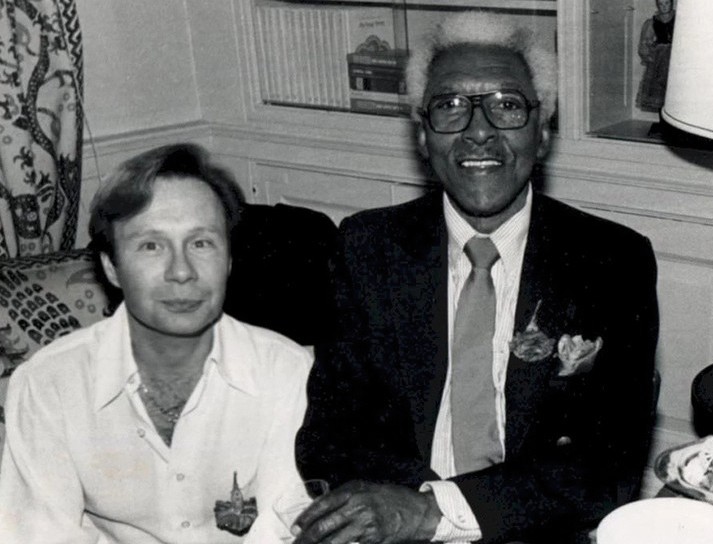Bayard Rustin – who was one of Martin Luther King’s key advisors, as well as a planner of the Montgomery bus boycott, a leader in his own right for social movements for peace, civil rights, non-violence, and LGBTQ+ rights – is famous today for organising the 1963 March on Washington – the political demonstration held on 28 August 1963, attended by an estimated 250,000 people to protest racial discrimination and to show support for major civil rights legislation that was pending in Congress.
In those days, because he was gay, Rustin’s name and accomplishments were hidden from public view, an injustice that was addressed posthumously when he was awarded the Presidential Medal of Freedom by President Barack Obama in 2013.
I saw Rustin first when I was a young lad of 15. It was in Trafalgar Square, London, in April 1958,
at the first Ban the Bomb rally. He was tall and slim and spoke clearly, distinctly, and energetically, with Nelson’s Column rising iconically at his back. Rustin was the only American and Black person to speak at the rally – the same event where the Campaign for Nuclear Disarmament (CND) first revealed the now ubiquitous peace sign. Rustin was the American who brought the peace sign to the USA.
Our paths and passions crossed (his major, and mine minor) from that Easter Friday 1958 to today and beyond, through peace activism, and fighting and poverty, among other causes. And, of course, co-operatives.
Related: How a credit union took the civil rights path to become a national lender
In 2023, Netflix released Rustin, a full-length movie about his life. The first 15 minutes of the film mostly take place in 1963, at two co-op apartments in Penn South, a limited equity housing co-op at 8th Avenue, New York City.
The co-operative link there is that in helping to create the National Consumer Cooperative Bank (NCCB), I attended meetings at Penn South in NYC in the early 1980s. At the time, I did not know Bayard Rustin still lived there (he died in the co-op in 1987). I shared the same roof as Rustin when I stayed in the co-op apartment of Dave Smith, then president of Penn South. Smith was one of the great outspoken supporters of what NCCB could do for limited equity housing co-operatives. As co-leader of the California effort to get Congress to pass the NCCB Bank Bill, the Penn South union-sponsored low-moderate-income housing co-op was a poster child for those who could be served.
Later, while writing about the Penn South Co-op’s role in birthing the idea of the March on Washington, I came across a link to Rustin’s partner, Walter Naegle, with whom I shared correspondence.
Naegle shared with me a personal story that related specifically to the Penn South Co-op. The co-op apartments at Penn South in NYC were very low-cost given it was a limited equity housing co-op. However, given that Rustin was over 30 years older, he would likely die before Naegle. The laws at the time (the 1950-60s) did not allow gay people to marry and the by-laws of Penn South ordained that a co-op apartment could only be passed down to either the remaining legal spouse or the children of the member.

With Naegle not legally fitting either category upon Rustin’s death, he was destined to lose his ability to live in the co-op apartment. In a brilliant move, Rustin adopted Naegle as his son. When the law confirmed that Naegle was his legal son, Rustin added Naegle’s name to his co-op membership and lease. Here in 2024, Naegle at 76 is a co-op member and still living in Rustin’s co-op apartment.
Two co-op apartments at the Penn South Co-op played a most critical role in the birth, initiation and planning of the march. One of the co-op apartments is Rustin’s own and the other co-op apartment is that of Rachelle Horowitz, then a young labour organiser.
Related: A look at the co-op connections of civil rights leader John Lewis
It was in Bayard’s distinctly furnished apartment that the first discussions took place of the March on Washington. At that first meeting were Bayard, his then partner Tom Kahn, and Congress on Racial Equality (Core) organisers Norman and Velma Hill and Horowitz. (all at one point member/residents at Penn South). As time went on, the meetings brought in more people and the organising phase began.
In the film, you can see a gathering of activists in Horowitz’s co-op apartment. Among them are many of the key people who organised the March on Washington – and one of my own co-op heroes: Ella Baker, who developed co-operatives for civil rights group NAACP and other organisations.
Horowitz has recounted to me that over the six months working with Rustin, she housed several of the march’s activists at her co-op apartment. During the summer of 1963, she hosted Eleanor Holmes Norton (now the non-voting Congress member for Washington, DC) and two organisers from the Student Non-Violent Coordinating Committee (SNCC) from Mississippi, the sisters Joyce and Dorie Ladner.
Bob Dylan was smitten by Dorie and came over to the Horowitz apartment in the late evening to serenade her with songs he was rehearsing for the march. Dylan also practised another song, Outlaw Blues, written with Dorie in mind, for a Civil Rights fundraiser in Mississippi, where he was due to perform.
On top of all this activity in her small apartment, John Lewis also turned up. He had been told by his hotel to stop rehearsing out loud his March on Washington speech as the booming noise through the plasterboard walls was disturbing other guests. As a result, Horowitz invited Lewis over to run through his speech in her soundproofed brick wall co-op apartment.
“Because the four young workers on the march had to get some sleep, Rachelle Horowitz had the historical task of at different times kicking both Dylan and John Lewis out of her co-op apartment,” Velma Hill told me.
From a small office in Harlem, the Penn South contingency was at the heart of organising the March on Washington. At 24, and without a driver’s licence, Horowitz headed up the plan to get 250,000 people by plane, train, bus and car to the march.
When it was proposed by A. Philip Randolph that his long-time skilled advisor Rustin be named as the director of the march, Roy Wilkins, head of the NAACP, angrily vetoed the appointment. Wilkins did not want a gay former communist to be linked with the march at all – never mind being the face of it. As a result, A. Philip Randolph, revered president of the Brotherhood of Sleeping Car Porters, stepped forward to be the director. Wilkins was gratifyingly pleased and voted for the motion. As director, Randolph then astutely appointed Rustin as his chief organiser.
Although Rustin spoke at the March on Washington, he was the only speaker not named in the programme. Today thankfully is an era when Bayard Rustin does not need to hide or to be hidden any more.

